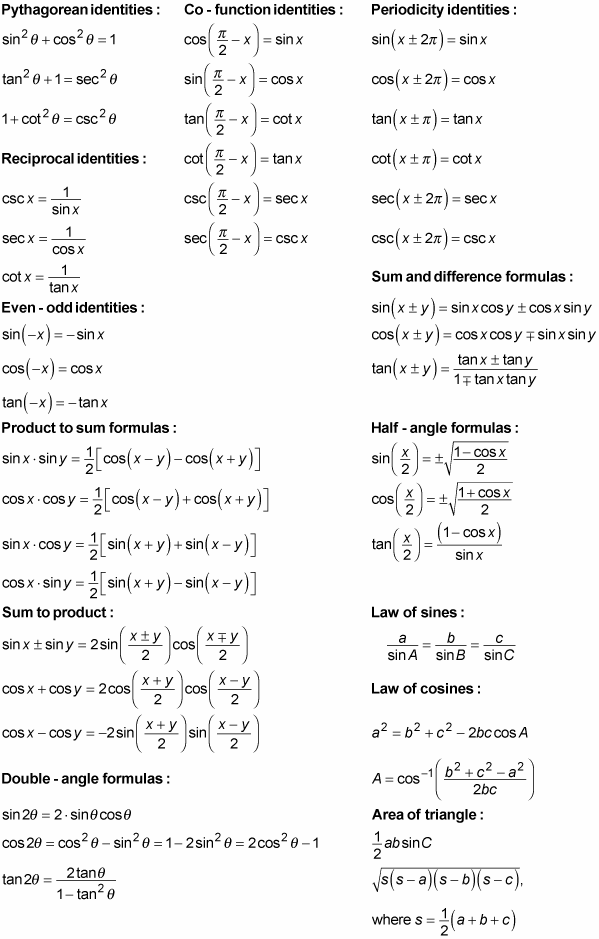I had to memorize that for calculus 2 and you have trouble remembering. 1- sneak, 2- lockpick 3- steal 8-repair ect...?
This is a bit off-topic, but more than half of those equations are unnecessary. The fact that someone is memorizing all of that by rote is a good indication that they don't understand what trigonometric functions are.
You don't need to memorize a single one of those equations. Draw a circle and a triangle is all you need to find all of them.
Unit circle:
From this you get all periodicity identities, co-function identities, reciprocal identities and even-odd identities.
Since it's an unit circle, you know that every point satisfies the equation:
x² + y² = 1. So, for a given point (x0,y0), we know that exist a θ such that x0 = cos(θ) and y0 = sin(θ), thus:
1 = x0² + y0² = cos²(θ) + sin²(θ). So you also get the pythagorean identities.
Law of sines:
Area of triangle is base * height / 2. So:
A = c/2 * (b*sin(α)) = b/2 * (a*sin(γ)) = a/2 * (c*sin(β))
Multiplying both sides by 2/abc:
A2/abc = sin(α)/a = sin(γ)/c = sin(β)/b
Law of cosines:
This is the only one that applying good old geometry is more hardwork than just going for the vector method:
c = a-b
Taking the dot product of both sides with c:
<c,c> = <c,a-b>
and since c = a-b:
<c,c> = <a-b,a-b>
Now, applying the dot product properties:
<c,c> = <a,a> + <b,b> - 2<a,b>
Now, <c,c> = c², <a,a> = a², <b,b> = b² and <a,b> = a*b*cos(θ), where θ is the angle between vector a and vector b, we have:
c² = a² + b² - 2*a*b*cos(θ)
Sum and difference formulas:
A = (cos(α), sin(α))
B = (cos(β), sin(β))
Now, distance between A and B:
AB² = (cos(α) - cos(β))² + (sin(α) - sin(β))²
AB² = (cos²(α) + sin²(α)) + (cos²(β) + sin²(β)) - 2(cos(α)cos(β) + sin(α)sin(β))
AB² = 2 - 2(cos(α)cos(β) + sin(α)sin(β))
Now, applying the law of cosines on AB:
AB² = A² + B² - 2cos(α-β)
Since A² = B² = 1, we have:
2 - 2cos(α-β) = 2 - 2(cos(α)cos(β) + sin(α)sin(β))
Thus:
cos(α-β) = cos(α)cos(β) + sin(α)sin(β)
You can get the rest by applying the same idea.
Now, you can see how to get the double-angle formula, product to sum formula, sum to product formula and half-angle formulas all from the sum and difference formulas. You can also get the co-function identities from here if you want.
Heron's formula(the last one in the area of triangle part) can be proved using law of sines and is left as an exercise for the reader.
As you can see, you can calculate all of that by drawing a circle and a triangle. And yes, I have autism.








![The Year of Incline [2014] Codex 2014](/forums/smiles/campaign_tags/campaign_incline2014.png)



















 )
)










